Search the Special Collections and Archives Portal
Search Results
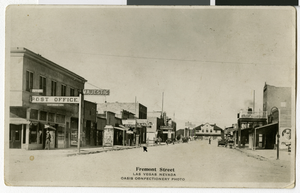
Postcard and photographs of early Las Vegas buildings, circa 1914
Date
Archival Collection
Description
Image

Transcript of interview with Marshall Mack Dawson by Robert Maichle, November 1, 1979
Date
Archival Collection
Description
On November 1, 1979, Robert Maichle interviewed Marshall Mack Dawson (born 1938 in Las Vegas, Nevada) about his experiences living in Las Vegas. Dawson first talks about his early education, his family, and the Old Las Vegas Mormon Fort. He then describes the changes he has noticed over time, the atomic testing, the Helldorado parades, Red Rock, the development of the Strip, and the changes in the Downtown area. Dawson also discusses some of his work for Nevada Power, the early movie theaters, his opinions on journalism, and various other topics.
Text

Transcript of interview with Roger Hurley Dudley by Beth McLaren, March 7, 1981
Date
Archival Collection
Description
On March 7, 1981, Elisabeth McLaren interviewed blackjack dealer, Roger H. Dudley (born August 10th, 1940 in Las Vegas, Nevada) in his home. This interview covers Roger’s recollections on growing up in Las Vegas. During the interview they further discuss Roger’s childhood, his parents, grade school, World War II, the atomic testing, the Mesquite Club, the development of the Strip, rodeos, Howard Hughes, Paradise Valley and changes in Las Vegas, Nevada.
Text
Transcript of interview with Count Guido Roberto Deiro by David G. Schwartz, January 30, 2002
Date
Archival Collection
Description
Count Guido Roberto Deiro, born in Reno, Nevada, in 1938, has had several fascinating careers. The son of vaudeville performer and recording star Count Guido Pietro Deiro, who was the first major piano-accordionist to become popular in the United States, and his teenage wife Yvonne Teresa LeBaron De Forrest, Deiro grew up in and around Las Vegas and Southern California after his parents' 1941 divorce. After attending 13 grammar schools and five high schools, Deiro graduated from Las Vegas High School in 1955. During his youth, thanks to his stepfather Samuel "Baby Shoes" Prezant, Deiro had an early introduction to the Las Vegas gambling scene. Following a brief stint in the U.S. Army, Deiro worked a series of jobs, including parking cars, selling shoes, and driving an ambulance. He transitioned from working as a fitness instructor to being a lifeguard at the El Rancho Vegas hotel, all the while becoming interested in aviation. Deiro entered the gaming industry at the age of 19 and a half, when he began working as a dealer, having been taught by his stepfather. Breaking in at the Nevada Club, Deiro, who became known as "Bobby Blue Eyes," later worked at the New Frontier, Sands, El Cortez, and Holiday casinos. He provides a great deal of detail about the social world of Las Vegas casinos in the 1950s through the 1970s, with insight into many major personalities. While working in gaming, Deiro continued to pursue a career in aviation, acquiring in the early 1960s a commercial pilot license, instrument rating and instructor's certificate. He began working as a flight instructor and charter pilot at Thunderbird Field, now known as North Las Vegas Air Terminal. Deiro flew around the United States promoting Las Vegas and the airfield. After Howard Hughes purchased the airfield in 1967, Deiro stayed, ultimately becoming Director of Aviation Facilities for the Hughes Tool Company. Following his marriage to Joan Marlene Calhoun, Deiro moved to California, where he became Vice President and Director of Administration for Air California and Golden West Airlines, before serving with other companies owned by C. Arnholdt Smith. In 1971, Deiro returned to Las Vegas. Deiro then met artist Michael Heizer, who enlisted Deiro's help in scouting and securing locations for his Earth art installations. This led to Deiro's long involvement with that genre. In addition to these careers, Deiro was also influential in many key developments in Las Vegas, including the construction of the Las Vegas Motor Speedway and, with his wife Joan, several philanthropic endeavors. In this interview, Deiro shares his perspectives on his times and his impact on Las Vegas.
Text
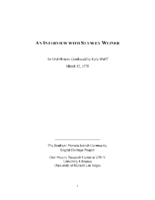
Transcript of interview with Stanley Weiner by Kyle Wolff, March 12, 1978
Date
Archival Collection
Description
Interview with Stanley Weiner by Kyle Wolff on March 12, 1978. In this interview, Weiner begins by talking about his father's employment, and then his own series of jobs, including as a department manager at Sears. He discusses living in different parts of town, population growth, educational opportunities, transportation, and recreation. The interviewer asks specific questions about sports, hotels, unions, and the weather.
Text

Transcript of interview with Louis Fisher by Samuel Barto, March 20, 1978
Date
Archival Collection
Description
On March 20, 1978, collector Samuel Barto interviewed paint and drywall contractor, Louis Fisher (born July 10, 1922, in Alva, Oklahoma) in North Las Vegas, Nevada. The interview took place at the collector’s home with the collector, Mr. Barto and Mr. and Mrs. Fisher present. Mr. Fisher relocated to Las Vegas in 1953 after having lived in Alva, Oklahoma, Portland, Oregon, and Walla Walla, Washington. During the interview, Mr. Fisher discusses the history of Las Vegas from 1953 and offers key insight into the rapid growth of Las Vegas with special focus on the Strip, banks, the steady influx of people moving to Las Vegas for the warm climate, and housing.
Text
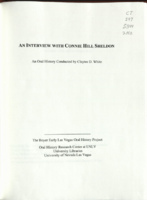
Transcript of interview with Connie Hill Sheldon by Claytee White, February 11, 2013
Date
Archival Collection
Description
Connie Hill Sheldon and her identical twin, Billie, also were members of Rancho High School 's first graduating class of 1962. Connie and Billie were born in 1944 in Oklahoma and spent their early years in southern California before moving to Las Vegas in 1956 with their mother, brother, and stepfather, Gerald Elmore. In Las Vegas Connie and her siblings attended Sunrise Acres Elementary School before going to Rancho, and the family was active with Homesite Baptist Church. While she was at Rancho Connie worked at the Huntridge Theater, and she continued working there after she graduated. In 1968 Connie married fellow Rancho '62 classmate Clyde Sheldon in Goldfield, Nevada. At the time of their marriage Clyde was an active-duty Marine. Over the course of his twenty-year USMC career the Sheldons lived in several places, but following his 1983 retirement they returned to Las Vegas and then moved to Pahrump. In this interview Connie particularly focuses on military life in New Yo
Text
Audio clip from interview with J. David Hoggard, February 1, 1999
Date
Archival Collection
Description
In this audio clip, J. David Hoggard discusses the local chapter of the NAACP in Las Vegas and the Human Relations Commission.
Sound
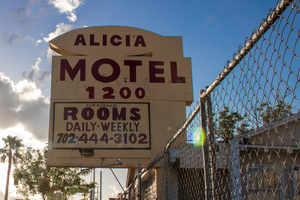
Photographs of Alicia Motel sign, Las Vegas (Nev.), April 18, 2017
Date
Archival Collection
Description
Site address: 1200 Fremont St
Sign owner: 1200 Fremont LLC
Sign details: .30 acre lot that was bought in 2013 for $3 million dollars, but motel is currently not in business. Originally constructed in 1944.
Sign condition: 2 - all 3 (for Alicia Motel 1-3) signs are in bad condition, holes all over especially the bottoms, still mostly readable. Paint and letters chipping off, no traces of neon, bulbs, or anything that would've made it light up.
Sign form: Back-to-Back
Sign-specific description: Simple geometric shape, mostly rectangular, with an oval shape on top. Simple designed of the name of the motel, "Alicia" is in the oval shape bubble, "Motel" in the top rectangle shape. "Rooms Daily and weekly" along with the businesses old phone number on the bottom of the sign. Extremely faded yellow coloring, heavy sun damage and a lot of the paint is chipped off hardly legible. No visible lighting components of any kind on the sign. Is double sided but is not very tall, (maybe 10-15 feet tall).
Sign - type of display: Textual
Sign - media: Steel
Sign environment: Property is by a residential area, along with other motels and shopping centers
Sign manufacturer: No external markings for sign company or designer
Sign - date of redesign/move: was the "Star View" Motel before it turned into Alicia Motel in 2006, originally had neon but was removed once it changed to Alicia Motel.
Survey - research locations: Motel website, www.roadarch.com, assessor's website
Surveyor: Danny Jacobs
Survey - date completed: 2017-08-12
Sign keywords: Steel; Paint; Back to back; Backlit; Pole sign; Neon
Mixed Content
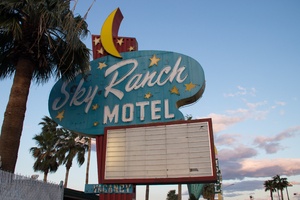
Photographs of Sky Ranch Motel sign, Las Vegas (Nev.), April 18, 2017
Date
Archival Collection
Description
Site address: 2009 Fremont St
Sign owner: Sky Ranch Motel INC
Sign details: .57 acre lot, original constructed in 1954.
Sign condition: 3 - seems in one piece, broken neon tubing, sun damaged paint (faded), lettering is still legible. No lettering on reader board.
Sign form: back to back pylon sign/monument sign
Sign-specific description: Abstract design, has a crescent moon form on top. Stars painted on and framed with skeleton neon tubing, skeletal neon around "sky ranch motel" and "no vacancy". Primary colors used, yellow for moon and star details, blue for the abstract bubble framing the name of the motel, yellow on sides of the bubble, red for the sides of the moon, reader board and its frame, and the base of the sign. Moon on top would internally light up on its own.
Sign - type of display: Neon, readerboard, internally illuminated moon
Sign - media: Steel and Plastic
Sign environment: Property is surrounded by motels and residential
Sign - date of redesign/move: Repainted in 2006, was a darker blue previous
Sign - artistic significance: Celestial theme popular during the Space Race era of the 1950s and 1960s.
Survey - research locations: Motel website, assessor's website
Survey - research notes: Approached office staff, owner was not in but I left my number and email at the front desk, no response.
Surveyor: Danny Jacobs
Survey - date completed: 2017-08-12
Sign keywords: Neon; Steel; Plastic; Reader board; Back to back; Internally illuminated; Pole sign
Mixed Content
